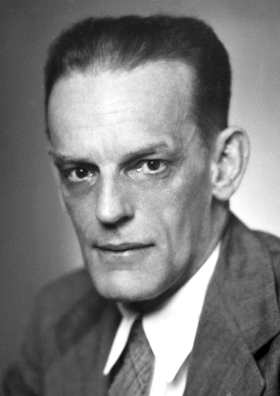Max Theiler facts for kids
Quick facts for kids
Max Theiler
|
|
|---|---|

Theiler in 1951
|
|
| Born | 30 January 1899 |
| Died | 11 August 1972 (aged 73) New Haven, Connecticut, U.S.
|
| Nationality | South Africa, American |
| Known for | Developing a vaccine against yellow fever |
| Awards | Chalmers Medal (1939) Lasker-DeBakey Clinical Medical Research Award (1949) Nobel Prize in Physiology or Medicine (1951) |
| Scientific career | |
| Fields | Virology |
Max Theiler (born 30 January 1899 – died 11 August 1972) was a doctor and a scientist who studied viruses. He was born in South Africa but also became an American citizen.
In 1951, he won the Nobel Prize in Physiology or Medicine. He earned this important award for creating a vaccine in 1937. This vaccine helped protect people from a very dangerous disease called yellow fever. Max Theiler was the first person born in Africa to ever win a Nobel Prize.
Contents
Max Theiler's Early Life and Studies
Max Theiler was born in Pretoria, which was then the capital of the South African Republic. Today, Pretoria is part of South Africa. His father, Arnold Theiler, was also a scientist who studied bacteria in animals.
Max went to school at Pretoria Boys High School. He then studied at Rhodes University College and the University of Cape Town Medical School. He finished his medical degree in 1918.
After his studies in South Africa, he moved to London, England. There, he continued his medical training at St Thomas's Hospital Medical School and King's College London. He also studied at the London School of Hygiene and Tropical Medicine. In 1922, he earned a special diploma in tropical medicine and hygiene.
Starting a Science Career
Max Theiler wanted to spend his life doing scientific research. So, in 1922, he moved to the United States. He started working at the Harvard University School of Tropical Medicine in Cambridge, Massachusetts.
For several years, he researched diseases like amoebic dysentery. He also tried to create a vaccine for a sickness called rat-bite fever.
Discovering Yellow Fever's Cause
Later, Max Theiler began working on yellow fever. In 1926, he and his colleague Andrew Sellards proved that a scientist named Hideyo Noguchi was wrong. Noguchi had thought yellow fever was caused by a type of bacteria.
However, Theiler and Sellards showed it was not bacteria. In 1928, they confirmed that a virus caused yellow fever. They also found that the yellow fever viruses from Africa and South America were the same type.
During this research, Max Theiler actually caught yellow fever himself. Luckily, he recovered and became immune to the disease.
In 1930, Theiler moved to the Rockefeller Foundation in New York. He later became the director of their Virus Laboratory. From 1964 to 1967, he also taught at the Yale School of Medicine.
Creating the Yellow Fever Vaccine
Max Theiler made a huge breakthrough with the yellow fever virus. He found that if he passed the virus through laboratory mice, it became weaker. This weakened virus could then give immunity to monkeys without making them very sick.
This discovery was a big step towards making a vaccine for humans. Theiler first created a special test to see if experimental vaccines worked. This "mouse protection test" was used for many years. It involved injecting blood from vaccinated people into mice. If the mice were protected from the yellow fever virus, the vaccine was working.
Developing the 17D Vaccine Strain
The Rockefeller team worked hard to find a very weak version of the virus. They used a strong strain of the virus from West Africa called "Asibi." They grew this virus in chicken embryos, a method developed by Ernest Goodpasture.
Their goal was to find a version of the virus that would not kill mice when injected into their brains. It took until 1937 and over 100 attempts using chicken embryos. Finally, Theiler and his colleague Hugh Smith found a weakened strain. They named it "17D."
Tests on animals showed that the 17D mutant virus was safe and could protect against yellow fever. Theiler's team quickly finished developing the 17D vaccine. The Rockefeller Foundation then started testing it on people in South America.
Between 1940 and 1947, the Rockefeller Foundation made over 28 million doses of this vaccine. This vaccine helped to stop yellow fever from being a major disease around the world.
For his amazing work, Max Theiler received the 1951 Nobel Prize in Physiology or Medicine. He also won other awards, including the Chalmers Medal in 1939 and the Lasker Award in 1949.
Theiler's Mouse Virus Discovery
In 1937, Max Theiler also found another important virus. He discovered a tiny agent that could cause paralysis in mice. This virus is now known as Theiler's murine encephalomyelitis virus.
He found that this virus could not be passed to monkeys. Also, only some mice developed symptoms from it. This virus has been studied a lot and is now used as a model. Scientists use it to learn more about diseases like multiple sclerosis in humans.
Max Theiler's Family Life
Max Theiler married Lillian Graham (1895–1977) in 1928. They had one daughter together. Max Theiler passed away on 11 August 1972 in New Haven, Connecticut.
See also
 In Spanish: Max Theiler para niños
In Spanish: Max Theiler para niños

